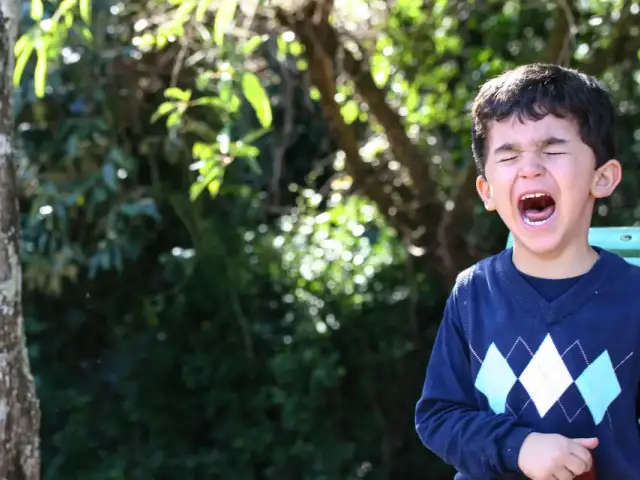My daughter Carys was two when she discovered the devastating injustice of gravity. She’d been carefully stacking wooden blocks into a tower. It was higher than any structure she’d built before, but the whole thing suddenly tumbled down. Within seconds, she was on the floor unleashing a wail that seemed to shake the windows.
My first instinct was familiar to most parents: How do I make this stop?
Later, I discovered: That was exactly the wrong question to ask.
X

Research tells us that tantrums aren’t breakdowns of behavior—they’re breakthroughs of communication. Understanding what’s really happening during meltdowns can help us respond to our children in a way that supports them… and makes things easier for us, too!
The science of tantrums
Research consistently finds that tantrums follow predictable age-related patterns. So, when do tantrums start? A 1931 study by Florence Goodenough found that tantrums peak between ages one and two at a rate of 1.4 outbursts per hour of observation, declining somewhat linearly to around 0.6 outbursts per hour at age five.
A tantrum is a negative emotional episode containing at least one of a set of behaviors, no matter how long the episode lasted. The behaviors included in the set were stiffening of the limbs and arching the back, dropping to the floor, shouting, screaming, crying, pushing or pulling, stamping, hitting, kicking, throwing, and running away. The tantrum officially begins when the first of these behaviors is noticed and ends when the last of them has stopped.
Tantrums seem to involve the expression of these emotions that overlap in the tantrum: anger and distress. High-anger tantrums include screaming, kicking, and hitting behaviors that peak quickly at the beginning. Distress tantrums involve crying and comfort-seeking that increase over time.
When Carys collapsed after her tower fell, she wasn’t manipulating me, or “testing boundaries.” She was experiencing what researchers call “anger-distress”—a flood of emotions that her developing brain couldn’t yet organize into words. It seemed to go on forever, but it didn’t. Studies say that most tantrums last just three minutes, with the majority under six minutes. The duration doesn’t seem to be affected by the child’s mood before the tantrum or the issue that triggered it. If the child stamped or dropped to the floor in the first 30 seconds, the tantrum was likely to be shorter.
While you might feel like a bad parent when your child is screaming and kicking, the truth is your child’s behavior is perfectly normal and not the result of anything you did or didn’t do. Another study indicates that children aged three to four years have an average of one temper tantrum per day, with daily tantrums being considered more normative for children younger than three years.
When do tantrums stop? While they don’t disappear overnight, this research shows they become significantly less frequent as children approach school age.
What is the root cause of tantrums?
Understanding what’s behind the behavior is the key to experiencing fewer of them. Tantrums aren’t manipulation or defiance. They are your child’s way of communicating that something important is happening inside them. When we understand what that is, we can address some of their frustrations—and experience fewer tantrums.
Independence and physical task struggles. Studies show that frustration often peaks when children try to take on tasks just beyond their current skill level. Carys desperately wanted to build that tower. Her vision was clear, and she was motivated, but her fine motor skills weren’t quite ready for such architectural ambition. The gap between what she could imagine and what she could execute created an emotional storm. But underneath that frustration was an unmet need for autonomy—her deep desire to be capable and independent.
Frustration with limits and authority. Older research found that conflicts with authority become increasingly important in the second year of life, actually switching places with routine difficulties as the primary tantrum trigger. When you tell them they’re not allowed to jump on the couch, and they immediately melt down, the intensity of their response might seem disproportionate. But for them, it feels overwhelming and unfair.
Social conflicts and sharing struggles. Most children don’t develop the cognitive ability to share meaningfully until at least three and a half to four years old, yet many parents expect younger children to share. What we call “sharing” is actually quite demanding for young children. “Sharing” a toy really means “giving up the thing you have and really want to keep to someone else.” This is a concept that young children find confusing because when they have little understanding of time, they can’t comprehend how long it will be until they get a toy back, making them resistant to giving it up. The resulting meltdown isn’t about the toy. It’s about unmet needs for security and control in an unpredictable world.
Unmet basic needs. Research consistently shows that several basic human needs, when unfulfilled, commonly lead to tantrum behavior. Sometimes these unmet needs are obvious. If your toddler is hungry and tired, they’re much more likely to have a tantrum. These physical needs cause tantrums because when our basic needs aren’t met, our ability to handle frustration plummets. Other times, the need is less apparent but equally important. When they’re trying to tell you something important about their day, but you’re distracted by your phone and give them a distracted “mm-hmm.” That unmet need for connection—for your full attention and genuine interest—can quickly escalate into a tantrum that you might think came out of nowhere.
The best way to respond to tantrums
Your emotional state during your child’s tantrum matters more than you might realize. Children co-regulate with their caregivers, meaning they borrow our calm when they can’t find their own. Your nervous system becomes their emotional anchor.
1. Stay regulated yourself. When you feel that familiar surge of anger—you know the one, where your chest gets tight and your jaw clenches—try to be mindful of how you breathe. You can try breathing in for four counts, holding for four, and breathing out for six. This will give you enough space to respond instead of react.
In the heat of a tantrum, it’s so easy to think, “They’re doing this to me” or “They should know better by now.” But when you can catch yourself and shift to thinking “This isn’t personal, my child is dysregulated,” it changes everything.
This reframe doesn’t excuse difficult behavior. We still need to guide our children toward better ways of expressing their needs. But it helps you respond from a place of understanding rather than that hot surge of frustration that makes everything harder for everyone.
2. Understand the phases. The groundwork for tantrum conversations happens long before any meltdown occurs. When you’re reading books together, ask about how characters might be feeling: “Look at Max’s face here—his eyebrows are down and his mouth is tight. How do you think he feels?” You can also print a feelings list, and ask your child to identify which feeling they are experiencing in calm moments.
Just remember that you can’t always tell how a person feels from their facial expression! It’s always safer to hypothesize (“Hannah is crying; I wonder if she’s feeling upset?”) than state with certainty (“Hannah is upset”). Hannah may well be angry rather than upset!
During a tantrum, your child’s body is constantly communicating. The anger phase hits first and hard. This is when you’ll see intense screaming, kicking, hitting, and back-arching. During this phase, if you try to offer physical comfort, they’ll likely resist your touch. Watch for these signs that the anger is subsiding:
- the screaming and yelling become less intense;
- kicking slows down or stops;
- the rigid, arched posture starts to relax;
- crying becomes more prominent than shouting.
These shifts signal that your child is moving into the distress phase, when comfort and connection become not just welcome, but necessary for recovery.
3. Don’t punish, but don’t give in. Avoid saying phrases like “You’re OK,” “Stop crying,” or “Big girls/boys don’t cry.” These messages dismiss your child’s very real emotions and can actually make them feel more misunderstood.
Don’t give in to demands just to stop the tantrum, but also don’t use this vulnerable moment to impose additional consequences or punishments. Your child isn’t choosing to have a tantrum—they’re overwhelmed and need your help getting back to calm.
Finally, avoid taking it personally or responding with your own big emotions. When you match their intensity with anger or frustration, you’re asking a dysregulated child to regulate an adult, which is impossible and unfair.
4. Validate your child’s experience. The conversation after a tantrum is where real learning happens, but timing is crucial. Wait until your child is fully regulated—not just done crying, but actually calm and connected again.
You can use the Validation Ladder when talking to your kids:
- Be present: Put down your phone, get down to their level, and give your child your full attention without waiting for your turn to speak or planning what you’ll say next.
- Accurately reflect: Try saying something like, “What I’m hearing is that you felt really angry when I said it was time to leave the playground. Is that right?” This shows your child that their feelings matter enough for you to really understand them.
- Contextualize or equalize: You can contextualize by saying, “You’ve been looking forward to the playground all morning, so it makes complete sense that you’d feel upset when it was time to go.” Or equalize with, “Transitions are hard for lots of people. Even grown-ups don’t like it when fun things have to end.”
- Make a proposal: Dig a little deeper with something like, “I’m wondering if maybe you felt disappointed about leaving, but also worried that we wouldn’t come back to the playground again soon?”
- Express true empathy: When you say “That sounds really disappointing!,” let your voice carry real understanding.
- Take action: Consider what you could do differently: “I’m thinking you might have felt more frustrated because I sprung the transition on you suddenly. Next time, I could give you a five-minute warning so you have time to finish what you’re doing.”
When children feel their emotions are accepted and understood, they’re more likely to move through difficult feelings without escalating to a tantrum.
This validation approach isn’t some permissive parenting technique where we say yes to everything. It’s not about throwing out boundaries. It’s about understanding what our kids are really trying to tell us when they fall apart.
5. Building support over time. As children develop language and Self-awareness, these conversations can gradually include their preferences for support. But this happens slowly, through many small interactions rather than one big discussion.
You might notice patterns and reflect them back: “I’ve noticed that when you’re really upset, you like me to sit near you but not touch you right away. Is that right?” Or offer simple choices during calm moments: “Next time you have big feelings, would it help if I sit close or give you some space?”
6. Try to be curious. The next time you witness your child’s emotional outburst or even someone else’s, try listening for the message beneath the behavior. What might they be trying to tell you about their inner world? What need might be driving this intense way of communicating?
When we approach tantrums with curiosity instead of frustration, we’re not just surviving those difficult parenting moments. We’re also teaching our children that their emotions matter. That they can trust us with their biggest, messiest feelings. And that there are better ways to communicate when the world feels completely overwhelming.
That’s a lesson that extends way beyond childhood. It shapes how they’ll work through relationships and handle emotional challenges throughout their entire lives.
The transformation really does begin with a simple shift in the question we ask ourselves. Instead of “How do I stop this?,” we should start asking “What are you trying to tell me?” That one change can change everything.













